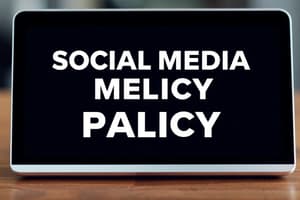Podcast
Questions and Answers
Which of the following exemplifies how media policy shapes content?
Which of the following exemplifies how media policy shapes content?
- Deciding who owns media outlets and what content is permissible. (correct)
- Establishing trade agreements related to media distribution.
- Determining the cost of internet access for consumers.
- Influencing lobbying efforts by public interest groups.
In Canada, what entities are primarily responsible for shaping media policy?
In Canada, what entities are primarily responsible for shaping media policy?
- The CRTC, the government, and corporate stakeholders. (correct)
- Lobbying firms and municipal governments.
- International organizations and public interest groups.
- Individual media consumers and advocacy groups.
What is the main purpose of the Canadian Broadcasting Corporation (CBC)?
What is the main purpose of the Canadian Broadcasting Corporation (CBC)?
- To ensure net neutrality among internet service providers.
- To provide Canadian content and promote national identity. (correct)
- To protect creative works through copyright laws.
- To regulate broadcasting and telecommunications in Canada.
What is the primary role of the CRTC in Canada's broadcasting and telecommunications landscape?
What is the primary role of the CRTC in Canada's broadcasting and telecommunications landscape?
Which principle ensures that Internet service providers treat all online content equally?
Which principle ensures that Internet service providers treat all online content equally?
Which concept allows the limited use of copyrighted material without permission for purposes like education or commentary?
Which concept allows the limited use of copyrighted material without permission for purposes like education or commentary?
What does 'piracy' refer to in the context of media and copyright?
What does 'piracy' refer to in the context of media and copyright?
Which movement advocates for unrestricted access to software and creative content, fostering collaborative environments?
Which movement advocates for unrestricted access to software and creative content, fostering collaborative environments?
How do regulations differ from legislations in the context of media policy?
How do regulations differ from legislations in the context of media policy?
What characterizes 'chain ownership' in media?
What characterizes 'chain ownership' in media?
What does 'vertical integration' refer to in the context of media ownership?
What does 'vertical integration' refer to in the context of media ownership?
What is the best description of 'conglomerated ownership' in the media industry?
What is the best description of 'conglomerated ownership' in the media industry?
Which of the following is an example of a governmental body establishing media policy?
Which of the following is an example of a governmental body establishing media policy?
Apart from governments, which entities can influence media policy through non-governmental policies?
Apart from governments, which entities can influence media policy through non-governmental policies?
What is the typical duration of copyright protection for an author's work?
What is the typical duration of copyright protection for an author's work?
What is 'technological convergence' in the context of media?
What is 'technological convergence' in the context of media?
How is 'industry/corporate convergence' best exemplified?
How is 'industry/corporate convergence' best exemplified?
What does 'media content convergence' describe?
What does 'media content convergence' describe?
What concern arises from non-neutral networks regarding internet service providers?
What concern arises from non-neutral networks regarding internet service providers?
What is the main focus of political economy studies in the context of media?
What is the main focus of political economy studies in the context of media?
Flashcards
What does media policy do?
What does media policy do?
Sets rules and guidelines shaping how media operates, including ownership, content, and public service.
How does media policy work?
How does media policy work?
Governments create policies through laws and regulations, influenced by corporations, public interest groups, and lobbying.
Who makes media policy in Canada?
Who makes media policy in Canada?
In Canada, media policy is shaped by the CRTC, the government, and corporate stakeholders.
What is the CBC?
What is the CBC?
Signup and view all the flashcards
What does the CRTC do?
What does the CRTC do?
Signup and view all the flashcards
Media Concentration & Monopoly
Media Concentration & Monopoly
Signup and view all the flashcards
Net Neutrality
Net Neutrality
Signup and view all the flashcards
Copyright & Fair Use
Copyright & Fair Use
Signup and view all the flashcards
Piracy
Piracy
Signup and view all the flashcards
Open Source
Open Source
Signup and view all the flashcards
Political Economy of Communication
Political Economy of Communication
Signup and view all the flashcards
Market Externalities
Market Externalities
Signup and view all the flashcards
What is policy?
What is policy?
Signup and view all the flashcards
Convergence
Convergence
Signup and view all the flashcards
Industry/Corporate Convergence
Industry/Corporate Convergence
Signup and view all the flashcards
Markets and Media Ownership
Markets and Media Ownership
Signup and view all the flashcards
Chain Ownership
Chain Ownership
Signup and view all the flashcards
Conglomerated Ownership
Conglomerated Ownership
Signup and view all the flashcards
Intellectual Property & Copyright
Intellectual Property & Copyright
Signup and view all the flashcards
Public Domain
Public Domain
Signup and view all the flashcards
Study Notes
- Policy sets rules and guidelines for media operations, governing ownership, content, and public service.
- Policy creation involves governments using laws and regulations, influenced by corporations, interest groups, and lobbying.
- Canada's media policy is shaped by the CRTC, the government, and corporate stakeholders.
- The CBC is Canada's public broadcaster, funded to provide Canadian content and promote national identity.
- The CRTC regulates Canadian broadcasting and telecommunications for fairness, diversity, and Canadian content.
- The Broadcasting Act & Telecommunications Act governs Canada's broadcasting and telecom industries, setting rules for media ownership, competition, and content regulation.
- Media concentration occurs when a few companies own most media outlets, reducing viewpoint diversity (e.g., Bell, Rogers, Telus).
- Net Neutrality ensures internet service providers treat all data equally, without blocking, slowing, or charging extra for access.
- Copyright protects creative works, while fair use/fair dealing allows limited use for education, commentary, or research without permission.
- Piracy is the unauthorized use or distribution of copyrighted content, exemplified by illegal downloading.
- Open Source promotes free access to software and creative works, encouraging collaboration like Linux or Wikipedia.
- The political economy of communication involves social and power relations in the production, distribution, and consumption of communication resources.
- Market externalities are the costs and benefits of economic activities not accounted for in economic transactions.
- Chain ownership involves horizontal integration of companies in the same business.
- Vertical integration concentrates firms to extend control over production and distribution.
- Conglomerated ownership defines large companies with both related and unrelated subsidiaries.
- Policy is a set of rules, laws, and practices governing an activity.
- Legislation refers to acts and statutes passed by Parliament or a provincial legislature.
- Regulations detail the practical application of laws and are assigned within an Act.
- Governmental policy is established by governmental bodies at municipal, provincial, or federal levels.
- Non-governmental policy includes company policies and industry regulations.
Key players in Policymaking
- Governments at all levels create legislations, taxation, trade agreements, and culture (CUMSA).
- State-funded institutions, subsidies or grants, and public/private partnerships are examples of governmental policy
- International organizations, companies, corporations, and institutions of all kinds also make policies.
- Canadian media policy focuses on economic development and national identity.
- The Broadcasting Act aims to preserve Canadian identity within broadcasting and requires media to be distinctly Canadian.
- Policy debates happen, such as Bill C-11 and the online streaming act.
- The CRTC regulates Canadian radio, television, and telecommunications including content.
- The Broadcasting Act of 1932 promoted Canadian media ownership, representing Canadians in a cultural, political, and social context integrating both private and public broadcasters.
- The Telecommunications Act regulates Canadian carriers, preventing them from controlling content or influencing telecommunications' meaning.
- Canadian media policy creation started with the AIRD commission in 1929.
- The Canadian Radio Broadcasting Commission followed in 1932, a public broadcaster that distributed licenses, later diluted into CBC and CRTC.
- Canadian media policy is free from foreign influence, emphasizes public ownership, universal service, promotes multiculturalism and regionalism, and protects charter rights and freedoms.
Intellectual Property Rights
- Intellectual property rights include patents, trademarks, and copyright.
- Expiration of copyright is usually seventy years after the death of the holder, or 95 years after publication for corporations.
- Public domain is where everyone can use something.
- Fair Use (US) and fair dealing (Canada) allow using copyrighted works for purposes that enhance the public good, with exceptions.
- The nature of the original work favors the use of nonfiction and news-based work over creative/artistic content.
- First sale and public lending rights permit copyright owners to dictate terms of the first sale; it applies less with each new system.
- APTN and Broadcast Policy is indigenous media policy in Canada.
Digital Media Policy
- Convergence is digital merging of analog technologies, media forms, and media industries.
Technological Convergence
- Merging technologies into one exemplified by smartphones.
- Industry/Corporate Convergence involves media companies owning/distributing types of media.
- An example includes Disney owning Marvel, ESPN, ABC, and Disney+ for content release across platforms.
- Media Content Convergence is a single story or brand that appears across platforms like books becoming movies, video games, and trends.
- Net neutrality refers to ISPs treating all content and applications equally, without degrading or prioritizing service.
- Concerns over non-neutral networks stem from potential financial interests in discriminating.
Internet & Media
- The internet and common carriage convergence challenge media concentration.
- Algorithms play a key part in this.
- Political economy studies power relations around the distribution, production, and consumption of products.
- Media ownership relates to capitalism and the influence of companies over media.
- Chain and conglomerated ownership infiltrate media platforms.
- Chain ownership is a singular company infiltrating multiple industries, like Amazon Prime, Amazon groceries, and Amazon delivery.
- Conglomerated ownership involves large companies with influence in related and unrelated industries, like Uber and Uber Eats.
- Analog convergence into digital has transformed into corporations concentrating digital media initially utilized as an open landscape.
- Market failures occur when costs and benefits aren't accounted for during economic transactions.
- Media democratization includes public service broadcasting.
- Intellectual property involves turning ideas into commodities through patents, trademarks, and copyright.
- Patents cover media hardware/software and new, useful, non-obvious inventions.
- Trademarks cover branding/advertising using words, symbols, and colors.
- Copyright covers original literary, artistic, and musical works.
- Arguments against copyright involve colonial implications and cultural appropriation/extraction.
Copyright
- Fair dealing limits scale and economic impact and includes making use of work without permission.
- Public domain works are accessible without copyright infringement.
- Copyrighted works are copyrighted for the author's lifetime plus an additional fifty years.
Media, Culture, and Society
- Commodity fetishism separates production from consumption, masking labor conditions from the consumer.
- Through commodity fetishism happiness and satisfaction can be achieved.
- Advertising/promotional cultures shape views on social issues.
- Ads create needs and transform desires.
- Ads and branding create values/expectations attached to a logo.
- Convergence the merging of analog technologies, media forms, and media industries.
- Raymond Williams defines culture as a way of life, high culture, and popular culture.
- Culture is lived but subconscious, existing beyond direct realization.
- Culture as a way of life involves intersectionality, while high culture links to higher class.
- Popular culture includes subcultures like Kpop, activism using graffiti, and children's media franchises.
- Moral economy explores moral justifications of economics.
- Using digital media entails hyper-consumption, environmental and labor costs.
- Environmental crisis is represented through citizen science, visual culture, and data visualization.
Technology and Society
- Algorithmic bias stems from prejudiced collection strategies in biased datasets.
- Biased algorithms are coded by human beings which will embed values.
- Implications of this bias include employment ranking software and anti-terrorism measures.
- Data brokers collect cookies/trackers.
- Data involves algorithms, machine learning, and automation using historical information to predict the future.
- There are ethical concerns, such as Amazon job applications automatically rejecting female applicants who applied.
- Material media is affected by technological development's impact on physical worlds.
- Environmental communication includes visual culture, data visualization, and environmental catastrophe.
- Media, labor, and technology are key areas of study.
- Industrial society features Fordism, Taylorism, and assembly lines.
- Post-industrial labor involves the information economy and immaterial labor.
- Precarious labor includes contractual, contingent, casual, or part-time work without benefits or security.
- The gig economy involves contracting out, platform labor, and models like Uber and Airbnb.
- Algorithmic control uses technology as an instrument for labor exploitation.
- Unions and resistance movements seek to challenge algorithmic logic and fight for regulation.
- Digitization and automation mediate work, while deskilling and alienation occur.
Studying That Suits You
Use AI to generate personalized quizzes and flashcards to suit your learning preferences.



